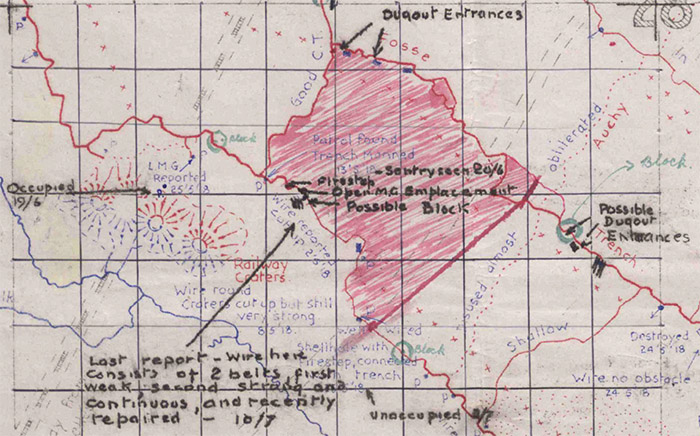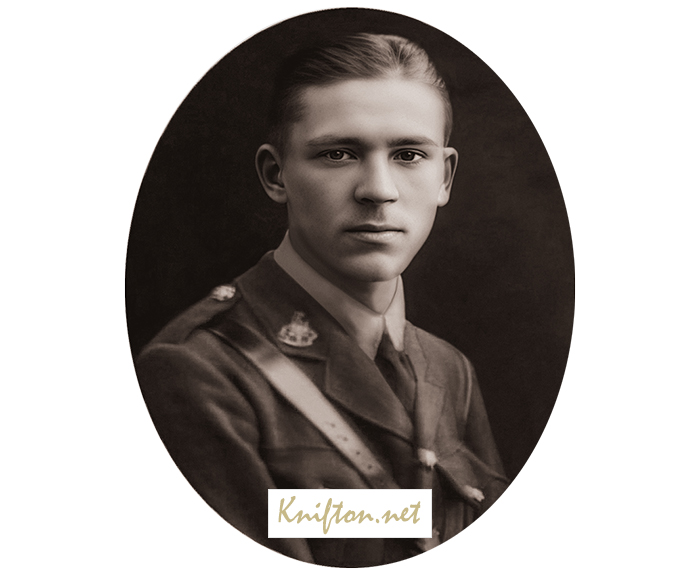


JAMES ALFRED McKINLAY KNIFTON 1899-1918
Second Lieutenant, Royal Sussex Regiment
By Kevin Knifton 12th September 2022
James Alfred McKinlay Knifton was the second of three children of John, a schoolmaster, and Agnes Mary Knifton (née McKinlay). He was born on 25th January 1899 at Plumstead, in London.
In June 1901, James was living at 30 Macoma Road, together with his parents, older brother Charles and younger brother Alfred. A few months later, in August, his brother Alfred died aged 2½ months.
James' grandfather James McKinlay died in 1901 and following his grandmother Agnes' death in 1907, the family moved to her former home at 7 Vicarage Park Road, Plumstead.
James was educated at St Olaves Grammar School, London. He joined the school in September 1910, aged 11, and left in July 1916, aged 17.
James enlisted after leaving school and, following in the steps of his brother Charles, moved to the Royal Military Academy at Sandhurst, where he was commissioned on 13th September 1917 as a 2nd Lieutenant with the Royal Sussex Regiment. Two months later, James would receive news that his brother Charles had been reported as missing and believed to be wounded.
Royal Sussex Regiment, 2nd Battalion
James served with the Royal Sussex Regiment. It appears that he initially joined the 3rd Battalion, but on 19th April 1918, he joined the 2nd Battalion at Cambrin, France. This was the same regiment which his brother had joined one year earlier. By this time, it was probably assumed that his brother Charles had been killed in action.
James joined his regiment on the front line where trenches had been 'blown flat' from enemy bombardment, and casualties from gas were increasing.
On 3rd May, James' regiment marched eight miles south to K Camp at Route D'Arras, where they undertook training until the 12th. News came that a German offensive was imminent, so on 12th May the Battalion marched back to the front line. However, the Battalion's war diary notes that 'it became apparent that the suspected enemy attack would not develop on our front' and on 20th May, James and his regiment moved to Annequin in support of another Brigade. They returned to the front line again on 25th May where 'we fired gas projectors on enemy lines. The enemy retaliated with fairly heavy shelling'. On 28th May James returned to billets in Noeux-les-Mines, but on 5th June he was back at the front line again. On 21st June he returned to billets at Noeux-les-Mines. The war diary notes that 'a number of officers and men in the Battalion contracted the "4 day fever" which was prevalent at the time.'
On 1st July, James travelled by lorry with his regiment west to Bois des Dames to take part in an inspection by H.R.H. The Duke of Connaught: 'The Brigade formed up in hollow square and was inspected by His Royal Highness, who then presented ribbons. The Brigade then marched past in column of route. After the inspection the Battalion returned in lorries to Noeux.'
James was again at the front line from 2nd to 12th July: 'The tour was a very quiet one and the most active patrolling on our part failed to discover any activity on the part of the enemy, who held his front line very lightly.' He returned to billets in Annequin on 12th July.
James was part of B Company and while at Annequin the war diary notes that 'B Company commenced training over a taped course for a one Company raid.' While the rest of the regiment went back to the front line on 17th July, 'B Company remained in Annequin and continued training for the raid.'
At midnight on the 20th/21st July, James was one of four officers who, together with 120 other men, took part in a raid on the enemy front line and support line trenches.
At 12:30 a.m. on 21st July, the raiding party moved from Annequin to the Hunster Tunnel. The men did not carry any form of identification; each being issued with a 'raid identity disc'. The disc worn by James carried the number L/84919. The objective of the raid was 'To secure casualties on the enemy and destroy his defences and dug-outs.' An intelligence map shows the raid area shaded in red, which was less than a mile south of Cuinchy.
 |
The dugouts on the 'enemy front line' appear to have been lightly populated. The report on the raid notes that 'Two enemy were seen...every effort was made to induce them to come out but they did not...the dugouts were bombed and the occupants undoubtedly killed. The remainder of the dugouts in the front line were empty.' The dugouts in the 'enemy 2nd line' were also mostly empty: the '2nd Wave of Infantry leap frogged and when the barrage lifted the enemy 2nd trench was easily captured...Many dugouts were found but only two appeared to contain any enemy...2 of the enemy fired out...both dugouts were destroyed...'
The Battalion's war diary notes that the raid was 'very successful which resulted in the capture of 2 machine guns.' However, the 'Report on Raid' concludes with 'Our Casualties', in which James was reported as 'missing believed killed'.
 |
Second Lieutenant James Alfred McKinlay Knifton was killed in action on Sunday 21st July 1918. He was 19 years old. His father John received administration for his effects on 16th July 1919 valued at £126. James was awarded the Victory and British medals which his father applied for on 15th November 1921.
James is remembered on the Loos Memorial to those who have no known grave.
On Sunday 13th June, 1920, a special service was held at St Andrew’s Presbyterian Church, Anglesea Road, Woolwich, during which a tablet which contained the names of fourteen men of the church or school who had lost their lives during the war. The tablet was unveiled by James' father John Knifton, and the names of both James and his brother Charles were listed.
TO THE GLORY OF GOD. THESE MEN left all that was dear to them, endured hardness, faced danger, and finally passed out of the sight of men by the path of duty and self-sacrifice; giving up their own lives that others might live in freedom: IVOR T. R. EDWARDS. PERCY FLYNN. DOUGLAS G. HAMMOND. CECIL W. HANNAFORD. WILLIAM A. HARRIS. CHARLES W. HODGIN. REGINALD JARVIS. CHARLES W. McK. KNIFTON. JAMES McK. KNIFTON. HERBERT C. LEE. GEORGE MACNAMARA. JAMES SMYTH. ERNEST E. THOMPSON. ALEC F. WRANGLE. |
Inscription on a memorial tablet originally at
St Andrew's Presbyterian Church, Anglesea Road, Woolwich
Three years after James went missing, in July 1922, his name was included in a Roll of Honour published in the Kentish Independent newspaper.
 |
 |
James Alfred McKinlay Knifton 1899-1918
In memory of Second Lieutenant JAMES MCKINLEY KNIFTON 3rd Bn. attd. 2nd Bn., Royal Sussex Regiment who died on 21 July 1918 |
Commonwealth War Graves Commission commemoration |